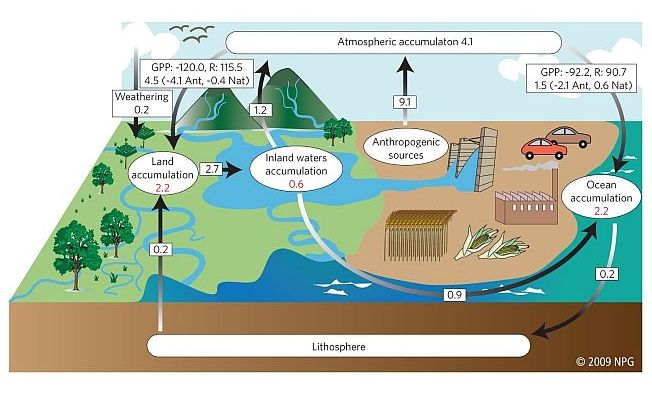FOR IMMEDIATE RELEASE: September 1, 2009
NEWS RELEASE
Avondale, Pa. – In the paper, The Boundless Carbon Cycle, published in the September issue of Nature Geoscience, scientists from the University of Vienna, Uppsala University in Sweden, University of Antwerp, and the U.S. based Stroud Water Research Center argue that current international strategies to mitigate manmade carbon emissions and address climate change have overlooked a critical player — inland waters. Streams, rivers, lakes, reservoirs, and wetlands play an important role in the carbon cycle that is unaccounted for in conventional carbon cycling models. The commentary comes just months before COP15, the December 2009 UN Climate Change Conference in Copenhagen where representatives from 192 countries will gather to decide upon a 2012 climate agreement that will succeed the “Kyoto protocol.”
Dr. Tom J. Battin of the department of Freshwater Ecology at the University of Vienna and lead author of the paper states that “While inland waters represent only 1% of the Earth’s surface, their contribution to the carbon cycle is disproportionately large, underestimated, and not recognized within the models on which the Kyoto protocol was based.”
The team of scientists points out that all current global carbon models consider inland waters static conduits that transfer carbon from the continents to the oceans. In reality, inland waters are dynamic ecosystems with the potential to alter the fates of terrestrial carbon delivered to them including: burial in sediments leading to long-term storage or sequestration; and metabolism in rivers and subsequent outgassing of respired carbon dioxide to the atmosphere.
“Twenty percent of the continental carbon sequestration actually occurs as burial in inland water sediments,” said Dr. Lars Tranvik, Professor of Limnology at Uppsala University in Sweden.
“River outgassing of respired carbon, contributes carbon to the atmosphere in an amount equivalent to 13% of annual fossil fuel burning,” said Dr. Anthony K. Aufdenkampe, a scientist at the Stroud Water Research Center. Because the amount of atmospheric carbon is well known and conservation of matter requires a balanced global carbon budget, this previously unaccounted for source of carbon to the atmosphere implies the existence of an additional continental carbon sink such as higher rates of biomass accrual in forests. “A larger accumulation of carbon in forest ecosystems that could offset the outgassing from rivers would be more consistent with current independently-derived estimates of carbon sequestration on the continents,” said Dr. Sebastian Luyssaert of the department of Biology at University of Antwerp in Belgium.
The authors feel that a Boundless Carbon Cycle — that accounts for carbon transfers between the land-freshwater boundary, the freshwater-atmosphere boundary, and regional boundaries within continents — presents opportunities and challenges for scientists and policy makers alike. They stress the need for collaborative scientific investigations augmented by new observatories and experimental platforms for long-term research to improve insights into carbon cycles across terrestrial and aquatic ecosystems. For policy makers, the authors note that riverine transport presents a book keeping challenge as carbon in rivers that escapes burial or outgassing flows downstream, traversing geographic regions and political boundaries, and thus altering regionally based carbon accounts.
About University of Vienna: The University of Vienna is the largest Austrian research institution. Approximately 6,500 scientists and academics guarantee its outstanding performance in research and teaching. The 15 Faculties and three Centres are dedicated to both basic and applied research.
The Boundless Carbon Cycle

Research now demonstrates that the processes of inland water ecosystems transfer significant amounts of carbon through the burial of sediments and the outgassing of carbon to the atmosphere—factors that are unaccounted for in climate change mitigation strategies and the carbon cycle models on which they are now based.
The schematic highlights carbon fluxes through inland waters, and also includes pre-industrial and anthropogenic fluxes. Values are net fluxes between pools (black) or rates of change within pools (red); units are Pg C yr (billion metric tons carbon per year); negative signs indicate a sink from the atmosphere. Gross fluxes from the atmosphere to land and oceans, and the natural (Nat) and anthropogenic (Ant) components of net primary production are shown for land and oceans. Gross primary production (GPP) and ecosystem respiration (R) are poorly constrained; we therefore modified respiration to close the carbon balance. Chemical weathering and non-biological dissolution of anthropogenic carbon dioxide by the oceans are also included. Fluxes to the lithosphere represent deposition to stable sedimentary basins and the flux from the lithosphere to land represents erosion of uplifted sedimentary rocks.


